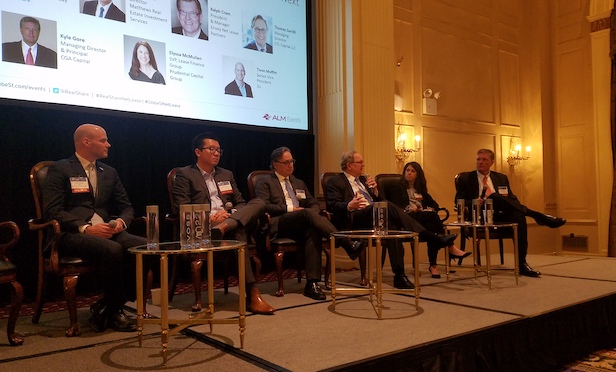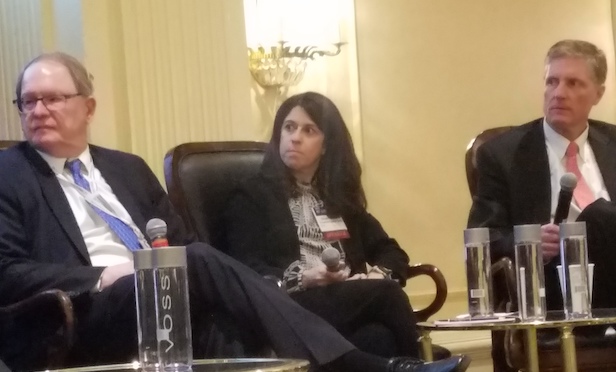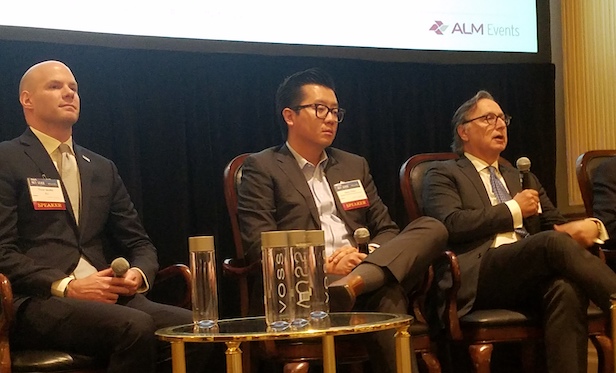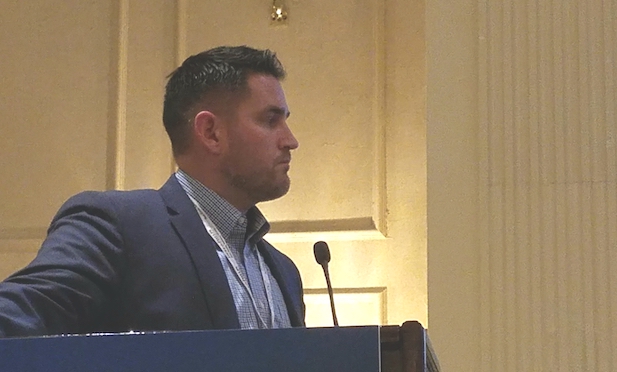 From left: Tivon Moffitt, Gary Chou, Thomas Zarrilli, Ralph Cram, Elyssa McMullen, Kyle Gore
From left: Tivon Moffitt, Gary Chou, Thomas Zarrilli, Ralph Cram, Elyssa McMullen, Kyle Gore
NEW YORK CITY—At GlobeSt.com's 17th Annual Net Lease Event, the “Capital Markets” panel, moderator Mark Maughan, head of net lease investments at Sundance Bay, asked all of the speakers to give the audience one NNN lease tip.
Future Net Lease Opportunities
Kyle Gore, managing director and principal at CGA Capital, predicted continued growth in healthcare. “Most major not-for-profit health systems have for-profit efforts which generate renenue to support their not-for-profit activities.” He pointed to growth in 24-hour patient care facilities and clinics, sports medicine, elective surgeries and high end treatment centers.
Elyssa McMullen, SVP, lease finance group at Prudential Capital Group, emphasized knowing market data.
Ralph Cram, president and manager of Envoy Net Lease Partners, stated demographics will determine a great deal about how the world uses real estate. Look at Gen X and millennials. Aligned with this strategy, following baby boomers, nursing homes, healthcare and regional hospitals will grow.
Thomas Zarrilli, managing director at CTL Capital, noted global trends. He pointed out that the same kinds of credit lease deals are closing internationally in the UK, Europe and in other locations.
Gary Chou, SVP and senior director, Matthews Real Estate Investment Group, said to keep an intelligent approach in watching trends and understanding the reasons they occur. He endorsed big box retail. “There is big box fear out there but it's a little too ridiculous. It's not going to evaporate. Yes, it's overbuilt but the market is pricing that.”
Tivon Moffitt, VP at JLL, acknowledged he's “a bit of a contrarian.” But he suggested investing in mid-term length retail leases and also mid- to short-term office leases. His advice was many people are afraid of these categories, so take advantage of these circumstances. Moffitt emphasized mid-term leased office buildings have renewal rates in the 90th percentile. “There are great opportunities out there,” he said.
Funding Net Lease Deals Today
Gore stated there are a lot of other institutional bond type investors in the field, non-bankers, institutional investors, typically bond-type investors, large insurance companies and pension funds. He added there are basically two firms that have pure play net lease financing: TIAA and Prudential Capital Group.
 From left: Ralph Cram, Elyssa McMullen, Kyle Gore
From left: Ralph Cram, Elyssa McMullen, Kyle GoreMcMullen stated Prudential's financing is ultimately based on the credit of the lessee. She highlighted one opportunity which has arisen in today's economy.
“If you have multiple disbursements and a draw schedule, there is some amount of delay and you pay for that,” said McMullen. “What's interesting now is the dollars that you need over a 24-month construction period as opposed to funding all the dollars on day one. The interest on day one can be a very expensive way to finance a project.” She noted short-term interest rates have picked up and long-term rates have significantly tightened. Thus, the incremental costs for delay can be nominal, allowing financing a project over an extended period of time at a very reduced cost.
She also highlighted additional contingencies can offset risks with less than ideal leases, which offer good marketing opportunities. Yet traditionally financing was not always so easy to obtain.
“For many years, institutional investors would refuse to participate in lease-backed transactions featuring construction and delivery risks. They would not accept the performance risk by an unrated borrower or developer alone unless that risk were fully mitigated by either a completion guarantee and 'absolute rent commencement date' agreement from the tenant, or covered by an irrevocable letter of credit for the entire amount of the financing,” said Gore. “The market has now evolved to the point that debt investors are willing to accept some construction and completion risk provided that sufficient reserves, borrower experience and contractor completion guarantees are in place.”
Some Things Happening with Developers Today
Cram said his company is seeing developers who have lost liquidity being unable to balance their loans. “The other thing we're seeing is contractors, more on the joint venture equity side are hiding financial problems,” he said. “It's really very important. Everyone has kind of overlooked this in this whole cycle but you really need to start looking at your contractors, asking for their financing statements.”
He also pointed out municipalities engaging in hiring freezes have resulted in building permit delays by three to six months.
 From left: Tivon Moffitt, Gary Chou, Thomas Zarrilli
From left: Tivon Moffitt, Gary Chou, Thomas ZarrilliChou said with the cost of labor and materials rising, developers are reducing the amount of product they make.
“In the last month or two, we've started to see contractors bid a little tighter and try to hook up some work for the next year or two because they've started to get a little worried about what's going to happen in a year if we get a recession,” said Zarrilli. “So we've seen pricing come up 5% to 10% tighter than we expected because they are reducing their profits.”
Some Things Happening on the Sales Side of Leasing
Moffitt said with the limited supply of office and industrial product, his firm is seeing some longer terms. “So a 15-year office lease, for example, that could be difficult to find if someone is going into a spec building or doing a recast of the lease, so we are seeing cap rates are hyper-aggressive in those positions.”
 Mark Maughan
Mark MaughanBut panelists also cautioned about paying attention to details including the assignment clause in the lease.
“All too often we receive inquiries from brokers and advisors claiming they have triple net leases from triple A tenants, only to then hear that same advisor say, 'Except for the fact that the tenant is unrated and the borrower is responsible for roof, structure, parking and lot maintenance,'” said Gore. “This chicanery has been going on for decades. What seems more acute now with a ton of capital is developers saying whatever they have to say.”
© 2025 ALM Global, LLC, All Rights Reserved. Request academic re-use from www.copyright.com. All other uses, submit a request to [email protected]. For more information visit Asset & Logo Licensing.








